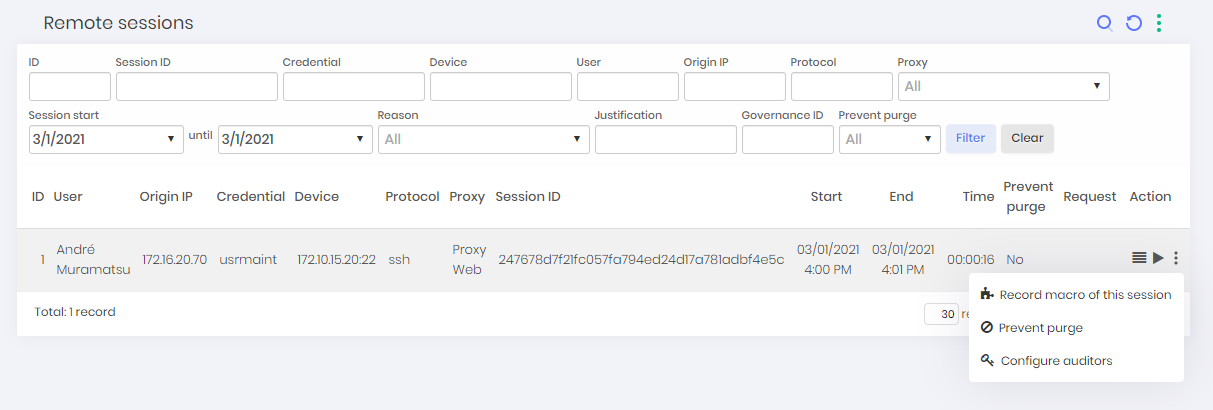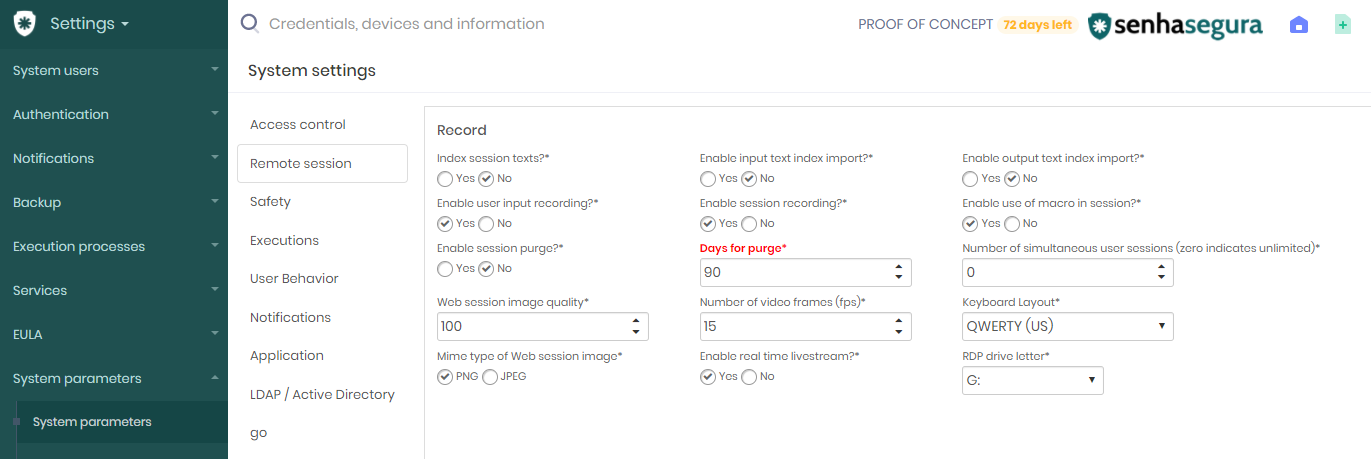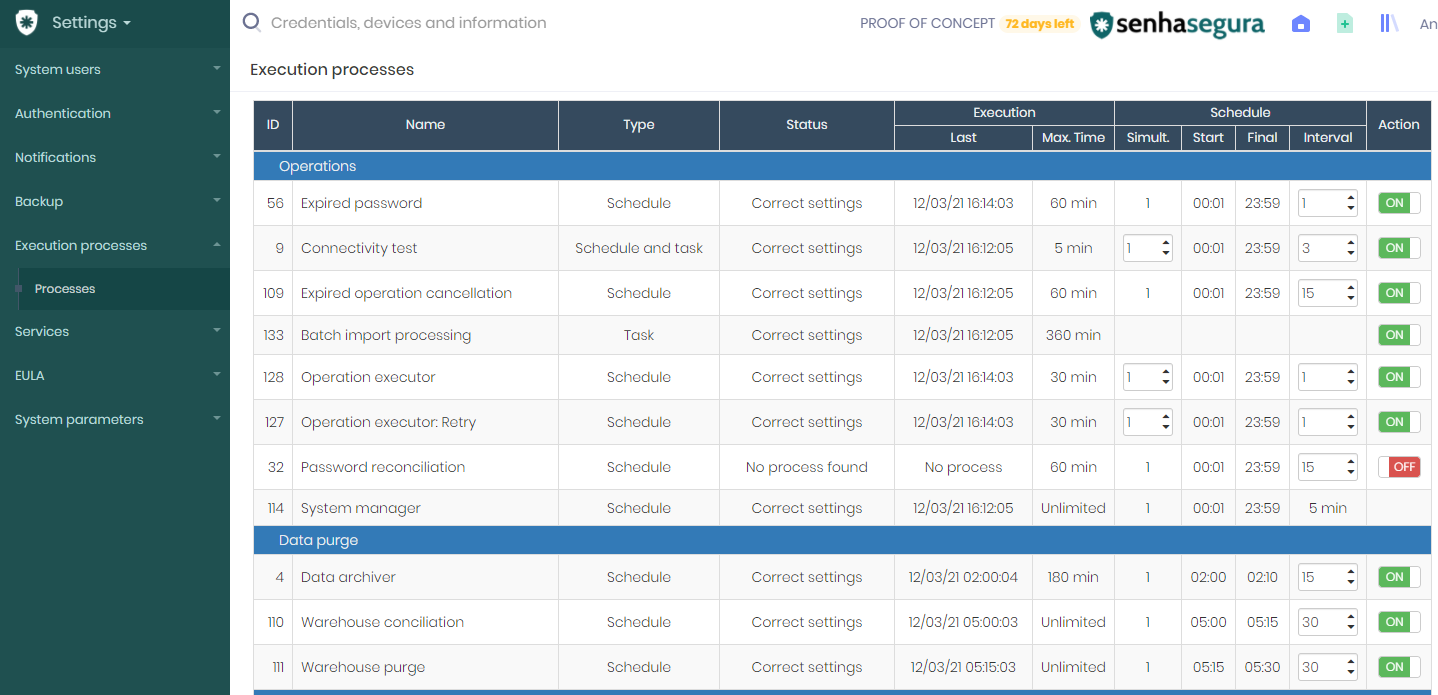Logs and data purge
senhasegura log rotates and data purge senhasegura has by default some particular database tables that are rotated by period. Many of these tables are used by the senhasegura Support Team for diagnostic and troubleshooting steps and do not affect the client operation at all. The only table witch interacts with client operation is the Email sent and Email received records. But all those data can be indexed by the client SMTP and POP3 provider. See below the rotated entities and their period.
Asynchronous tasks requests
All operational and log tables used by Orbini Asynchronous Tasks are rotated. The module which requested the operation will keep all operation records. These purged data does not have any client operation detail or sensitive data.
Orbini Assync PIDs: Records rotated on the 7th day. Has the execution timestamp and its internal used PID;
Orbini Assync Logger: Records rotated on the 15th day. Has process info and error messages;
Orbini Assync Tasks: Records rotated on the 30th day. Has the execution requests provided by clients modules;
Orbini User Notification: Records rotated on the 30th day. Has system messages sent to users;
Device Connectivity Tests: Records rotated on the 30th day. Registered devices connection test based on registered connections protocol;
LDAP Sync Logs: Records rotated on the 30th day. Used by Orbini LDAP Synchronizer for diagnosing and troubleshooting;
Orbini WebService A2A Requests: Records rotated on the 30th day. Has all clients requests to WebService A2A ;
Orbini Events: Records rotated on the 30th day. Has user data interaction timestamp log. Do not confuse with data events from each module. This table is used only for framework purpose;
Orbini Changed Data: Records rotated on the 30th day. Has user data interaction timestamp log. Do not confuse with data auditing from each module. This table is used only for framework purposes;
Orbini SMTP Emails: Records rotated on the 180th day. Have all emails sent by senhasegura . These emails can have sensitive information or module-specific information. The same data can be retrieved by the client SMTP server;
Orbini POP3 Emails: Records rotated on the 180th day. Have all emails received by senhasegura configured account. These emails can have sensitive information or module-specific information. The same data can be retrieved by the client SMTP server;
Orbini User Actions: Records rotated on the 300th day. Has all user data interaction and login/logout logs;
Session dump data purge
All proxy sessions are recorded into its raw protocol format, and stored inside senhasegura data storage. This data can be also copied to the client backup repository at the backup procedure.
These data will consume something next to the network traffic during a proxy session. There is no magic number to determine the size of a session raw replay file.
At time, the client will decide if the session should be keep or can be purged by senhasegura automatic purge process.
By default, senhasegura is configured with 90 days of session storage. So if a session has occurred more than 90 days ago, it will be automatically purged.
This report contains a list of session files stored in senhasegura:
In Settings → Services → Storage files, we can view information about the Storage files:
ID: is the file identifier.
Name: is the generated name for the file.
Type: is the type of file extension.
Account: this account is not editable by the standard user and the account report does not allow creating new accounts.
Upload: date and time it took place.
Purged: whether it was purged or not.
Status: whether this data is active in the system or not.
Path: the path that this file is on the system.
Prevent session purge
At the Remote sessions report, accessed by PAM Core ➔ Credentials ➔ Access control ➔ Remote sessions menu, the administrator can prevent the session purge clicking at Prevent purge action on the desired session record;

Change purge interval
At the Settings ➔ System parameters ➔ System parameters menu, go to the Remote session section and change the Days for purge field. You can change this field defining a new purge period from 1 day to 1000 days;

Disable purge service
The administrator can also inactivate all purge services at Settings ➔ Execution process ➔ Process menu, and disabling Data archiver and Warehouse purge services;
